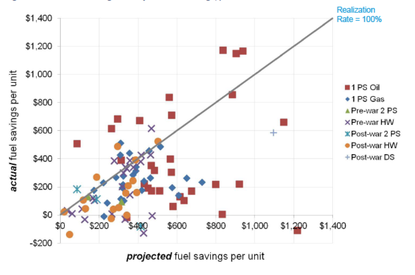
In this case, this study showed that "While fuel savings projections ranged from 25% to 50% across about two-thirds of the buildings, most projects actually saved 10% to 40%."
Although the retrofits saved energy, post-retrofit savings generally fell short of auditors’ projections. In Figure 14 at the left, the 1:1 line represents a realization rate of 100%, indicating post-retrofit savings that were exactly as predicted by the auditor. A majority of the buildings in the study fell below this 1:1 line, indicating they achieved realization rates below 100%. Across all projects, the fuel realization rate was 61% with a 90% confidence interval of ±14%.
The study goes on to suggest that as a way to deal with this over prediction bias, which it acknowledges is due to a variety of issues, not just modeling, projected savings should be downgraded not to exceed a linear relationship between actual savings and pre retrofit fuel use intensity. While this capping certainly reduces overprediction, it also has a number of other unintended consequences.
This essentially creates a penalty for deeper retrofits or those that spend the extra time and investment to actually achieve deeper savings. It essentially says you cannot get credit for investing in deep savings or quality work. This model has the consequence of creating an incentive to stay shallow, and keep it cheap.
Rather than just enforce and arbitrary cap, we think instead, using the standards such as those prescribed in the EDF Investor Confidence Project, we can create the dataset necessary to differentiate on the many influences of project performance, and avoid this serious unintended result.
The report states that "A variety of factors influence the ultimate accuracy of savings projections, including how much of the associated scope of work was implemented, equipment specifications, the quality of construction and ongoing facility management, and the quality of the energy audit. Nonetheless, there is no systematic means of quantifying the relative influence of each of these key factors individually across the DB/LC dataset."
Our focus should be on solving this issue and building the kind of dataset necessary to drive deeper and higher quality results. The eventual outcome of this kind of thinking is a system the encourages exactly the type of cream skimming that has prevented us from getting to the deep cost effective resource of energy savings.
Read the entire report at: https://www.db.com/usa/img/DBLC_Recognizing_the_Benefits_of_Energy_Efficiency_01_12.pdf

 RSS Feed
RSS Feed